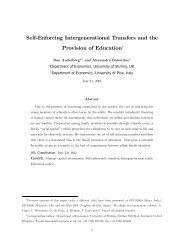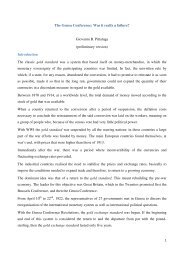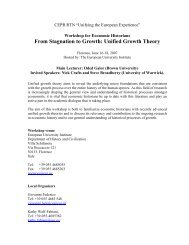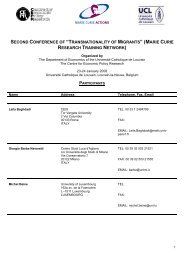MARKET STRUCTURE AND ENTRY: WHERE'S THE BEEF? - CEPR
MARKET STRUCTURE AND ENTRY: WHERE'S THE BEEF? - CEPR
MARKET STRUCTURE AND ENTRY: WHERE'S THE BEEF? - CEPR
Create successful ePaper yourself
Turn your PDF publications into a flip-book with our unique Google optimized e-Paper software.
the same way as the actions of the other strategic player. We have not gone beyond 1995<br />
in part for reasons of data availability and in part because the CJD (“mad cow”) beef<br />
scare is likely to have affected all players’ plans and consumption in 1996. Also, Wimpy<br />
might by then be argued to be (potentially at least) a strategic player in the local drive-<br />
through market.<br />
3.3. Data<br />
Briefly, the basic data on store locations and openings comes, in McDonalds’<br />
case, entirely from the company itself. These data are very high quality and very useful<br />
for other reasons. For example they establish that exit is a very unusual phenomenon;<br />
less than 1% of all the stores ever opened in the UK have closed. In the case of Burger<br />
King, the data come from more of a variety of sources, although we do have a complete<br />
listing of stores in 1995. Again, exit is unusual, though more common than for McD.<br />
The basic data on the demographic and other characteristics of local authority<br />
districts come from Regional Trends, the only consistent source of annual data at this<br />
level of aggregation. These two data sources (on outlets and on demographics) are<br />
matched using a Midas “Postzon” package based on UK postcodes. A third source (the<br />
“AA”’s “A to B”) gives distances between districts. More detail on construction of each<br />
of the variables, including definitions, sources and problems, is given in the Data<br />
Appendix, available on request.<br />
The estimation sample consists of five annual observations each for 452 districts<br />
- we exclude Northern Ireland, all small islands apart from the Isle of Wight, and three<br />
London boroughs (see footnote 5). For each such district market, we observe the<br />
geographical area and population, the proportion of under-16s and pensioners, the council<br />
tax rate, average wage rate, and unemployment rate. We also observe the market<br />
11









